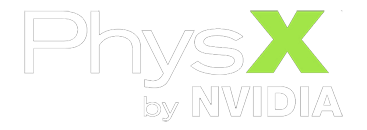PxRigidBodyFlag Struct Reference
[Physics]
Collection of flags describing the behavior of a rigid body.
More...
#include <PxRigidBody.h>
Public Types | |
| enum | Enum { eKINEMATIC = (1<<0), eUSE_KINEMATIC_TARGET_FOR_SCENE_QUERIES = (1<<1), eENABLE_CCD = (1<<2), eENABLE_CCD_FRICTION = (1<<3), eENABLE_POSE_INTEGRATION_PREVIEW = (1 << 4), eENABLE_SPECULATIVE_CCD = (1 << 5), eENABLE_CCD_MAX_CONTACT_IMPULSE = (1 << 6) } |
Detailed Description
Collection of flags describing the behavior of a rigid body.
Member Enumeration Documentation
- Enumerator:
-
eKINEMATIC Enables kinematic mode for the actor. Kinematic actors are special dynamic actors that are not influenced by forces (such as gravity), and have no momentum. They are considered to have infinite mass and can be moved around the world using the setKinematicTarget() method. They will push regular dynamic actors out of the way. Kinematics will not collide with static or other kinematic objects.
Kinematic actors are great for moving platforms or characters, where direct motion control is desired.
You can not connect Reduced joints to kinematic actors. Lagrange joints work ok if the platform is moving with a relatively low, uniform velocity.
Sleeping:
- Setting this flag on a dynamic actor will put the actor to sleep and set the velocities to 0.
- If this flag gets cleared, the current sleep state of the actor will be kept.
- Note:
- kinematic actors are incompatible with CCD so raising this flag will automatically clear eENABLE_CCD
- See also:
- PxRigidDynamic.setKinematicTarget() Enable kinematic mode for the body.
eUSE_KINEMATIC_TARGET_FOR_SCENE_QUERIES Use the kinematic target transform for scene queries. If this flag is raised, then scene queries will treat the kinematic target transform as the current pose of the body (instead of using the actual pose). Without this flag, the kinematic target will only take effect with respect to scene queries after a simulation step.
- See also:
- PxRigidDynamic.setKinematicTarget()
eENABLE_CCD Enables swept integration for the actor. If this flag is raised and CCD is enabled on the scene, then this body will be simulated by the CCD system to ensure that collisions are not missed due to high-speed motion. Note individual shape pairs still need to enable PxPairFlag::eDETECT_CCD_CONTACT in the collision filtering to enable the CCD to respond to individual interactions.
- Note:
- kinematic actors are incompatible with CCD so this flag will be cleared automatically when raised on a kinematic actor Enable CCD for the body.
eENABLE_CCD_FRICTION Enabled CCD in swept integration for the actor. If this flag is raised and CCD is enabled, CCD interactions will simulate friction. By default, friction is disabled in CCD interactions because CCD friction has been observed to introduce some simulation artifacts. CCD friction was enabled in previous versions of the SDK. Raising this flag will result in behavior that is a closer match for previous versions of the SDK.
- Note:
- This flag requires PxRigidBodyFlag::eENABLE_CCD to be raised to have any effect.
eENABLE_POSE_INTEGRATION_PREVIEW Register a rigid body for reporting pose changes by the simulation at an early stage. Sometimes it might be advantageous to get access to the new pose of a rigid body as early as possible and not wait until the call to fetchResults() returns. Setting this flag will schedule the rigid body to get reported in PxSimulationEventCallback::onAdvance(). Please refer to the documentation of that callback to understand the behavior and limitations of this functionality.
eENABLE_SPECULATIVE_CCD Register a rigid body to dynamicly adjust contact offset based on velocity. This can be used to achieve a CCD effect. eENABLE_CCD_MAX_CONTACT_IMPULSE Permit CCD to limit maxContactImpulse. This is useful for use-cases like a destruction system but can cause visual artefacts so is not enabled by default.
The documentation for this struct was generated from the following file:
Copyright © 2008-2017 NVIDIA Corporation, 2701 San Tomas Expressway, Santa Clara, CA 95050 U.S.A. All rights reserved. www.nvidia.com
